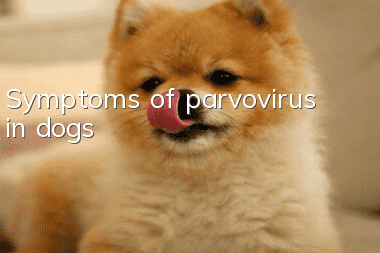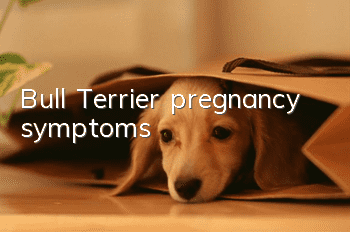Symptoms of parvovirus in dogs

After a dog becomes pregnant, the dog will have indigestion, vomiting, etc. in the early stages of the disease. The initial vomit will contain undigested food, and then the color of the vomit will gradually turn white and may appear. There is a small amount of bloodshot eyes. In the middle stage of the disease, the dog will appear listless, loss of appetite or loss of appetite, general weakness and weakness, and the body temperature will gradually rise to above 39 degrees Celsius. In the later stages of the disease, dogs will develop gastrointestinal symptoms, often passing bloody, watery feces with a foul odor.
How to prevent your dog from getting tiny
1. Don’t let your dog sniff and eat randomly
When you usually take your dog out, pet it The owner must keep an eye on the dog and do not let the dog sniff other dogs’ poop, urine, vomit, or saliva, and do not let the dog pick up food on the ground, and do not let the dog come into contact with other sick dogs. Address the root causes of infection risks.
2. Regular vaccination
The most effective way to prevent canine parvovirus is to vaccinate your dog regularly. First of all, give the dog a parvovirus vaccine once when it is 8-12 weeks old, then again 2 weeks later, and then once a year, and imported vaccines are recommended. In addition, please note that after vaccination, dogs will suffer from loss of appetite, vomiting and diarrhea, and decreased resistance. At this time, pet owners can feed the dog some probiotics to increase appetite and enhance resistance.
3. Avoid going to places where dogs are densely packed.
Places with dense crowds of people are full of bacteria, and so are places with lots of dogs. Therefore, when pet owners usually take their dogs out, it is best not to go to places with many dogs, such as pet trading markets and parks where many people walk their dogs. If you go, remember to disinfect after returning home.
4. Regular disinfection of the home
In addition to paying attention to the outside environment, pet owners should also pay attention to the environment at home. After all, dogs live at home most of the time. Therefore, pets should disinfect their homes regularly. First, you can use 1:30 diluted bleach to disinfect furniture, floors, etc., and then it is best to use pet-specific disinfectants to disinfect your dog's supplies.
5. Ensure that the dog’s diet is balanced
In addition to the aspects mentioned above, pet owners must also ensure that the dog’s diet is balanced. Do not feed your dog human food or food that is too cold, and do not feed your dog dangerous foods such as chocolate and onions. The kitchen trash can should also be sealed to prevent your dog from eating these foods and causing gastrointestinal discomfort, which may lead to parvovirus.
- Kennel Cough Symptoms and Treatment
- Causes and symptoms of sepsis in dogs
- Are Portuguese Water Dogs Smart?
- Neutering your dog is a big deal, here are a few things you should pay attention to:
- Why do dogs’ eyes become cloudy?
- How to train a Husky to learn to stand?
- DIY dog food-Homemade beef and pork liver dog food
- Sick dog care | How to care for a sick dog?
- 10 Mistaken Training Methods to Avoid When Your Puppy Enters a New Home
- Causes and solutions for irritable dogs



